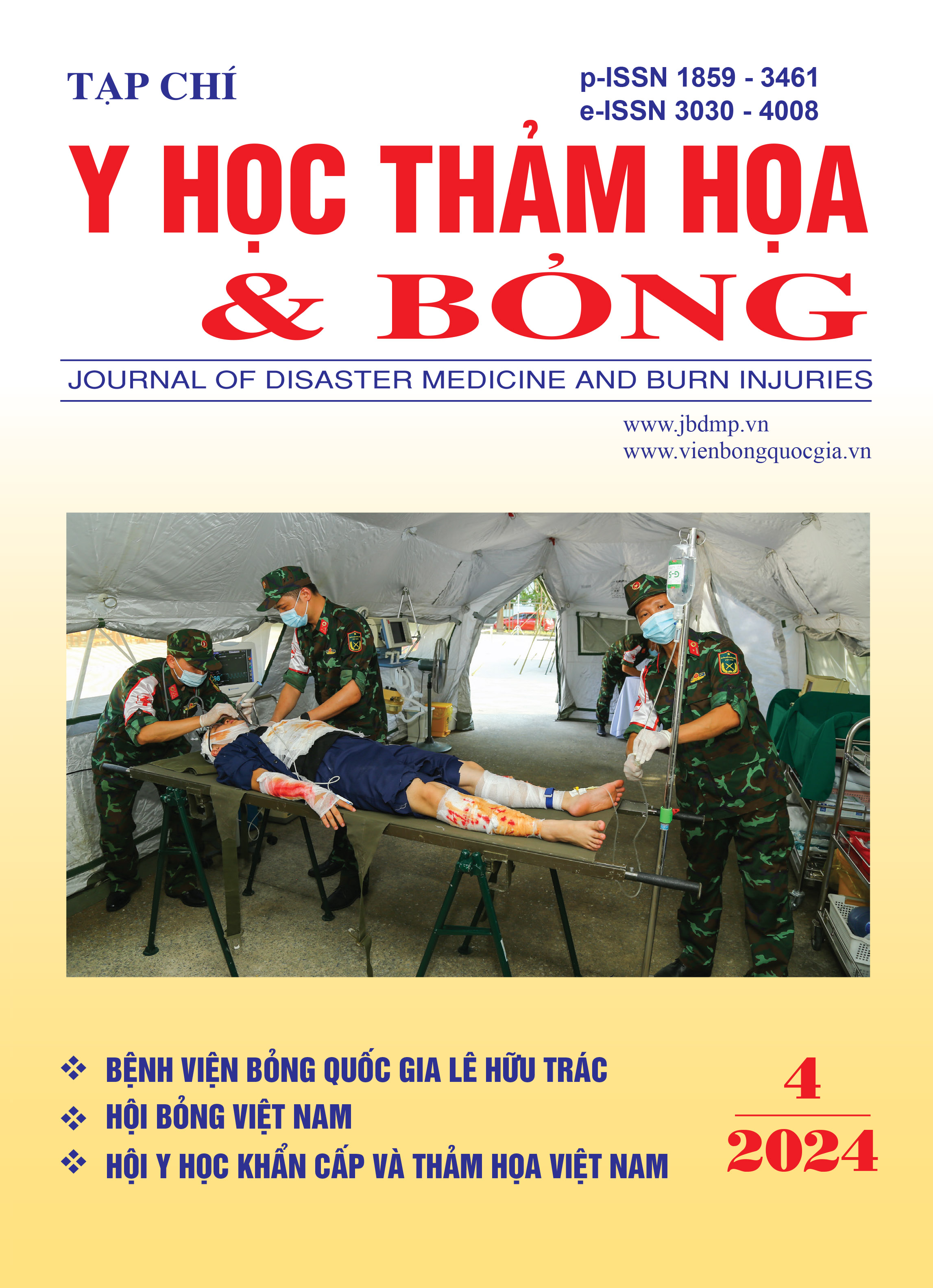Characteristics of plasma TNF-α and Interleukin-6 concentrations at the time of diagnosis of septic shock in severe burn patients
Main Article Content
Abstract
Objectives: identify characteristics of plasma TNF-α and interleukin-6 (IL-6) levels in severe burn patients at the time of septic shock diagnosis.
Subjects and methods: Cross-sectional study, descriptive at the time of diagnosis of septic shock in 54 times of septic shock in 37 severe burn patients (16-60 years old), treated at the Intensive Care Unit, Le Huu National Burn Hospital Trac from January 2023 to June 2024.
Results: At the time of diagnosis of septic shock, the SOFA score was 5 points, the APACHE II score was 20.82 points, and the number of failed organs was 1.51 organs; TNF-α and IL-6 concentrations were elevated (TNF-α: 20.54pg/mL (12.76 - 40.44pg/mL); IL -6: 645.45pg/mL (244.81 - 1011.28pg/mL). For every 10pg/mL increase in TNF-α, the risk of SOFA score increased by 0.2 times, MAP and ScvO2 decreased by 0.3 and 1.4 times, respectively (p < 0.05); for every 10pg/mL increase in IL-6, MAP and ScvO2 risk decreased by 0.04 times and 0.2 times, respectively (p < 0.01), arterial lactate increases by 0.01 times (p < 0.01).
Compared with septic shock patients with negative blood cultures, blood culture-positive septic shock patients had significantly higher plasma TNF-α and IL-6 concentrations at the time of septic shock diagnosis (p < 0.05). Plasma IL-6 concentration at the time of diagnosis of septic shock has a fairly good predictive value for positive blood cultures. The Hosmer - Lemeshow test showed that the regression equation was suitable for positive blood cultures (p > 0.05).
Conclusion: Plasma TNF-α and IL-6 concentrations were elevated in severe burn patients at the time of diagnosis of septic shock. The predictive value of positive blood culture of plasma IL-6 concentration was quite good in severe burn patients with septic shock.
Article Details
Keywords
Severe burns, septic shock, TNF-α, interleukin-6
References
2. Mariano F., Depetris N., Malvasio V., et al. (2020). Coupled plasma filtration and adsorption for severe burn patients with septic shock and acute kidney injury treated with renal replacement therapy. Burns, 46 (1), 190-198.
3. Chung K.K., Coates E.C., Smith D.J., et al. (2017). High-volume hemofiltration in adult burn patients with septic shock and acute kidney injury: A multicenter randomized controlled trial. Critical Care, 21 (1), 1-8.
4. Bottiroli M., Monti G., Pinciroli R., et al. (2017). Prevalence and clinical significance of early high Endotoxin Activity in septic shock: An observational study. Journal of Critical Care, 41, 124-129.
5. Fink M.P. (2006) The prevention and treatment of sepsis: is interleukin-6 a drug target or a drug? Critical care medicine, 34 (3), 919-921.
6. Tischendorf J., Yagmur E., Scholten D., et al. (2007). The interleukin‐6 (IL6)-174 G/C promoter genotype is associated with the presence of septic shock and the ex vivo secretion of IL6. International journal of immunogenetics, 34 (6), 413-418.
7. Rivers E.P., Jaehne A.K., Nguyen H.B. et al. (2013). Early biomarker activity in severe sepsis and septic shock and a contemporary review of immunotherapy trials: not a time to give up, but to give it earlier. Shock, 39 (2), 127-137.
8. Gharamti A.A., Samara O., Monzon A., et al. (2022). Proinflammatory cytokines levels in sepsis and healthy volunteers, and tumor necrosis factor-alpha associated sepsis mortality: A systematic review and meta-analysis. Cytokine, 158, 156006.
9. Finnerty C.C., Herndon D.N., Chinkes D.L., et al. (2007). Serum cytokine differences in severely burned children with and without sepsis. Shock, 27 (1), 4-9.
10. Wakabayashi A., Sawada K., Nakayama M., et al. (2013). Targeting interleukin-6 receptor inhibits preterm delivery induced by inflammation. Molecular human reproduction, 19 (11), 718-726.
11. Cong S., Ma T., Di X. et al. (2021). Diagnostic value of neutrophil CD64, procalcitonin, and interleukin-6 in sepsis: a meta-analysis. BMC Infectious Diseases, 21, 1-17.
12. Gille J., Jocovic J., Kremer T., et al. (2021). The predictive role of Interleukin 6 in burn patients with positive blood cultures. International Journal of Burns and Trauma, 11 (2), 123.


